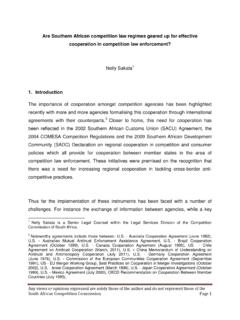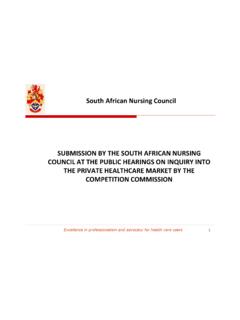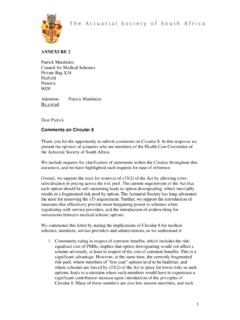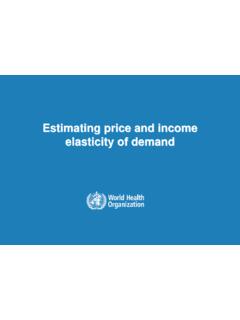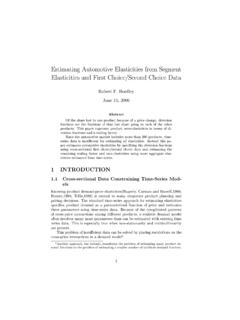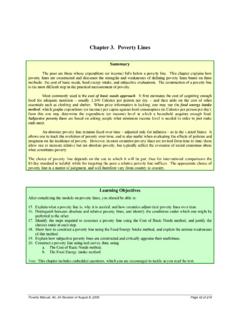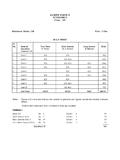Transcription of How competitive are markets for …
1 How competitive are markets for telecommunications services in SouthAfrica?Ryan Hawthorne 4 August 20161 IntroductionThe demand for mobile voice telecommunications services in South Africa is estimated in this paper, inorder to identify whether customers are responding to lower prices from challenger networks (Cell C andTelkom Mobile), or whether consumers are not responding. Consumers might not be responding for avariety of reasons, such as a lack of access to incumbent network (MTN, Vodacom) infrastructure andon-net discounting off retail prices by incumbent addition, own-price and cross-price elasticities of demand for mobile voice services are likely to bequite different in South Africa where the fixed line network has significantly less coverage, and where prepaidsubscribers account for the vast majority of subscribers.
2 Prepaid subscribers are likely to be more pricesensitive than postpaid subscribers. We would expect therefore that own-price elasticities of demand wouldbe reasonably elastic and that mark-ups for prepaid customers would therefore be low. If the mobileoperators are able to price discriminate between prepaid and postpaid subscribers, this would explain howthey have been able to cover their fixed costs in achieving full population coverage in a developing countrylike paper presents results for prepaid subscribers. First, a brief overview of the literature is provided,followed by a description of the methodology followed, and the dataset used.
3 Results are then presented,and these are followed by Literature reviewA number of papers have been written on the demand for telephony services . Vogelsang (2010) provides areview of this literature. Studies on market -level own price elasticities of demand show relatively inelasticdemand for mobile services (elasticities of between and ) (Vogelsang, 2010), which suggests thatthere is competition among mobile operators (since operators are not pricing at monopoly levels). Similarly,fixed line elasticities of demand are low and close to zero for access charges (Vogelsang, 2010).
4 Own priceelasticities of demand for fixed line usage charges are also low and are greater than 1 (Vogelsang, 2010).An important feature of these studies is that they ought to take into account both access and usagecharges (Hausmanet al, 1993), which some (but not all) do, as Vogelsang (2010) points out. Furthermore,considerable lengths are sometimes taken to try to generate differences in access charges which usually donot vary significantly over time within countries (Ward and Woroch, 2010).Grzybowski & Pereira (2007) find own-price firm-level elasticities of between and for mobileoperators in Portugal.
5 These relatively high levels of own-price elasticities imply relatively low mark-ups,and therefore limited market power of individual and Thompson (2005) measure market -level elasticities among a number of developed anddeveloping countries, and find market -level elasticities of between for developing, and fordeveloped countries. CCRED, University of Johannesburg; PhD candidate, University of Cape Town. I am grateful for extensive support frommy supervisors at the Universities of Cape Town and Johannesburg, including Lukasz Grzybowski, Simon Roberts and are also several papers on demand for telecommunications services in individual developing coun-tries.
6 Narayana (2008), for example, estimates demand for telephony services in India. He finds market -levelelasticities of demand for mobile services of for access charges, and for usage charges. Inaddition to access and usage prices, Narayana (2008) used income, family size, age, education, caste andoccupation as explanatory & Zheng (2012) find market -level elasticities of demand for mobile telephony of between and They studied demand for mobile services in 31 provinces in China between 1998 and 2007, and usedARPU as their proxy measure for price, relying on prices in neighbouring provinces as instruments for pricein any given summary, the existing literature on the demand for mobile telecommunications services suggeststhat markets are reasonably competitive , with relatively low market -level elasticities of demand (Vogelsang,2010).
7 This literature is somewhat inconclusive, however, partly due to the fact that finding high qualityprice data for different countries is difficult given the complexities of telecommunications prices (installation,access and usage prices), service quality and the variety of mobile services that are bundled with traditionmobile voice additional feature of the literature is that supply side considerations are not taken into account:developed countries have existing fixed line networks that are largely depreciated, while developing countriesdo not (Vogelsang, 2010).
8 Fixed lines may be more significantly cheaper in developed countries as a resultof this, which might lead to greater competition for mobile operators from fixed line operators, resulting inlower elasticities of demand for mobile services . This means that own-price firm-level elasticities of demandin developing countries might be quite different to those in developed paper will extend the literature on demand for voice telecommunications services , and will thusadd to the debate on estimating demand for mobile services , by using two unique datasets: the All MediaProducts Survey (AMPS) and unique pricing datasets (described below).
9 3 MethodologyDemand for mobile voice services will be estimated using a discrete choice framework. There are severalbehavioural modelling approaches to estimating discrete choice models of demand for consumer level data(Davis & Garces, 2010). These include multinomial logit, conditional logit, generalised extreme values(including nested logit), mixed logit and probit. Some of these models have closed form solutions, includingmultinomial logit and nested logit, while other models, including mixed logit and probit, require simulation(Train, 2009). The most widely used model for estimating discrete choice models of demand is the conditionallogit model, an extension of the multinomial logit (MNL) model (Mcfadden, 1973).
10 A MNL model will beestimated as follows:Consumeri s utility derived from productjis given by:Uij(pj,rj,zi; ) =Vij(pj,rj,zi; ) + ij(1)wherepjandrjare the price and intrinsic value, respectively, of productjandziis a vector of char-acteristics of consumeri. There is a vector of parameters to be estimated, , and a stochastic error term estimates are relative to the outside option, which is choosing no service at choose productjover productkifUij maxj6=k,k CiUikwhereCiis the choice occurs with the following probability:Pij=Pr[Vij+ ij maxj6=k,k CiVik+ ik](2)We assume that ijare independently and identically distributed (IID) across individuals and alternativesand follow a type I extreme value distribution and have a scale parameter.
